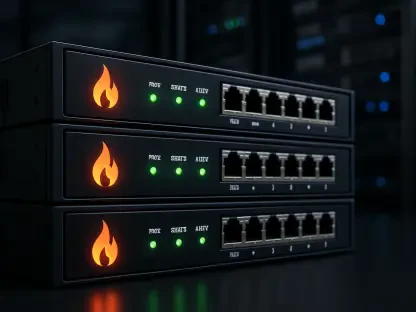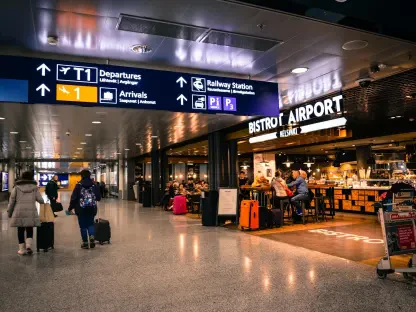Huawei caused a sensation at the Mobile World Congress in Barcelona by introducing its latest innovation, the Huawei Alpha Antenna, the digital mobile network antenna. This breakthrough technology signifies a major advancement in network optimization by offering dynamic adjustments of cellular signals in response to real-time user demands. The Alpha Antenna promises to revolutionize the way networks operate, paving the way for more efficient and intelligent network management.
The Drawbacks of Traditional Antennas
Historically, network operators have faced significant challenges in optimizing network performance due to the static nature of traditional antennas. These conventional antennas are configured to broadcast signals in fixed directions, regardless of user distribution and traffic demands. The lack of adaptability often leads to inefficiencies, akin to streetlights illuminating empty roads at full brightness. Network operators have had to contend with the limitations of static optimization, where the antennas do not dynamically adjust to changing conditions.
Traditional antennas require manual inspections and adjustments to correct misalignments, adding to the operational burdens faced by network operators. The process is not only time-consuming but also prone to human error, further compromising network efficiency. Moreover, static optimization fails to account for the ever-changing factors influencing user distribution, such as urban planning changes and new infrastructure developments, making it difficult for network operators to maintain optimal performance.
As urban landscapes evolve and user demands shift, traditional antennas struggle to keep pace. These fixed-beam systems operate like immovable spotlights, broadcasting signals irrespective of the real-time presence of users. The inefficacy of traditional systems in dynamically responding to traffic conditions results in wasted resources and diminished user experiences. As a result, operators are increasingly seeking more agile solutions that can adapt to the fluctuating demands of modern network environments.
Transition to Dynamic Optimization
Huawei’s Alpha Antenna marks a significant departure from the limitations of static optimization, introducing a dynamic approach to network management. This digital antenna is equipped with Huawei’s advanced Antenna Information Sensor Unit (AISU), allowing it to accurately and automatically retrieve base station parameters. This capability provides real-time data on the network’s state, including engineering parameters and beam shapes, enabling the system to dynamically adjust beam direction and width.
The Alpha Antenna’s dynamic optimization resembles the responsiveness of a self-driving car that adjusts its steering based on surrounding conditions. The antennas can shift their beams up to 30 degrees left or right to focus on areas with high demand, ensuring efficient management of network traffic. This adaptive mechanism allows the network to respond in real-time to shifting user distributions and varying traffic demands, optimizing performance and resource utilization.
In practical applications, the Alpha Antenna has demonstrated its effectiveness in field tests conducted in Shenzhen, China. The antennas automatically modify coverage patterns based on changing user needs, shifting their focus between residential areas and schools as traffic demand fluctuates throughout the day. This dynamic adjustment ensures that network resources are allocated efficiently, providing users with seamless connectivity and improved network performance.
The ability to dynamically optimize network coverage is of particular value in crowded venues such as stadiums and concert halls. The Alpha Antenna can automatically focus coverage on high-density areas during events and revert to standard patterns once the crowd disperses. This adaptability caters to the sporadic but intense data demands seen in public gatherings, ensuring users experience consistent connectivity and performance.
Frequency-Specific Beam Adjustments
A standout feature of the Alpha Antenna is its capability for frequency-specific beam adjustments. This technology enables different signal frequencies to be independently optimized, enhancing the efficiency of the network. By allowing frequency-specific adjustments, the Alpha Antenna can tailor its broadcast to meet diverse user requirements, optimizing performance across various usage scenarios.
This frequency-specific optimization is analogous to a smart vehicle that adjusts differently for varying road conditions. In practical applications, the Alpha Antenna has demonstrated its efficacy by automatically redirecting coverage beams based on real-time user needs. For instance, during field tests in Shenzhen, the antennas dynamically shifted their focus between residential areas and schools, adapting to the ebb and flow of traffic demand throughout the day.
This dynamic capability extends to high-density venues, such as stadiums and concert halls, where the Alpha Antenna can automatically concentrate coverage on areas with high user density during events. Once the crowd disperses, the antenna reverts to standard coverage patterns, ensuring consistent network performance irrespective of fluctuating user presence. This adaptability is crucial for maintaining optimal connectivity in environments with varying user densities.
The ability to adapt to urban development is another significant advantage of Huawei’s Alpha Antenna. As cities evolve and new infrastructure such as transportation hubs or residential areas are introduced, the Alpha Antenna can swiftly adjust its coverage to align with changing user distributions. This flexibility ensures that network performance remains optimal, future-proofing urban connectivity and enhancing user experiences.
Applications in High-Density Venues
The dynamic optimization capabilities of Huawei’s Alpha Antenna prove particularly valuable in high-density venues like stadiums and concert halls. These environments present unique challenges due to the sporadic but intense data demands generated during events. Traditional antennas struggle to maintain consistent performance in such scenarios, often resulting in degraded user experiences.
The Alpha Antenna addresses these challenges by automatically focusing coverage on high-density areas during events. This dynamic adjustment ensures that users in crowded venues experience seamless connectivity and optimal network performance. Once the event concludes and the crowd disperses, the antenna reverts to standard coverage patterns, maintaining efficient resource utilization without compromising performance.
In practical applications, the Alpha Antenna has demonstrated its effectiveness in high-density venues. During events, the antennas dynamically concentrated coverage on areas with high user presence, ensuring consistent connectivity and performance. This adaptive capability is crucial for maintaining optimal user experiences in environments with fluctuating user densities, catering to the unique demands of public gatherings.
The dynamic nature of the Alpha Antenna also proves advantageous in scenarios involving urban planning adjustments. As new transportation hubs or residential areas are introduced, the antenna can swiftly adjust its coverage to align with changing user distributions. This flexibility ensures that network performance remains optimal, future-proofing urban connectivity and enhancing user experiences in evolving urban landscapes.
Adapting to Urban Development
As urban landscapes continue to evolve, network operators face the challenge of maintaining optimal performance amidst changing infrastructure and user distributions. Huawei’s Alpha Antenna addresses this challenge by offering dynamic optimization capabilities that align network coverage with evolving urban environments. This adaptability is crucial for future-proofing urban connectivity and ensuring efficient resource utilization.
The Alpha Antenna’s ability to swiftly adjust coverage in response to urban development is a significant advantage. For instance, the introduction of new transportation hubs or residential areas often results in shifts in user density and traffic demands. Traditional antennas struggle to keep pace with such changes, compromising network performance. The Alpha Antenna, however, can dynamically adapt its coverage to match these evolving conditions, maintaining optimal performance.
Field trials have demonstrated the efficacy of the Alpha Antenna in adapting to urban development. Test results have shown significant improvements in network performance by dynamically adjusting coverage patterns based on real-time user distributions. This dynamic optimization enhances resource utilization and provides users with seamless connectivity experiences, catering to the unique demands of evolving urban landscapes.
The ability to adapt to urban development highlights the Alpha Antenna’s capacity for future-proofing network connectivity. As cities grow and infrastructure changes, the antenna can swiftly adjust its coverage to align with shifting user densities. This flexibility ensures that network performance remains optimal, enhancing user experiences and supporting the continued evolution of intelligent, adaptive networks.
Boosting Network Efficiency and Performance
Field trials have indicated that Huawei’s Alpha Antenna significantly boosts network efficiency and performance. These innovative antennas dynamically adjust to real-time user distributions and traffic demands, optimizing resource utilization and ensuring seamless connectivity experiences. Test results have shown improvements exceeding 60% in key optimization areas, highlighting the transformative impact of dynamic optimization.
The higher traffic handling capabilities of the Alpha Antenna contribute to a more robust and efficient network. By dynamically adjusting coverage patterns, the antenna ensures that network resources are allocated efficiently, optimizing performance and enhancing user experiences. This dynamic optimization is crucial for maintaining consistent network performance amidst varying user densities and traffic demands.
The Alpha Antenna’s ability to adapt to real-time conditions is akin to a smart vehicle that adjusts differently for varying road conditions. This adaptive capability ensures that the network can respond to fluctuating demands, providing users with consistent connectivity and optimal performance. The dynamic nature of the Alpha Antenna represents a significant advancement in network management, paving the way for more efficient and intelligent networks.
The innovative technology behind Huawei’s Alpha Antenna sets the stage for future advancements in intelligent network optimization. As networks become increasingly complex, driven by AI-generated content and higher data consumption, antennas will need to be intelligent and self-optimizing. The Alpha Antenna represents a pivotal step in this direction, offering a dynamic solution that aligns with real-time user distributions and traffic demands.
Industry Trends Toward Digitalization
The digitalization of antenna technology is key to managing the growing complexity of modern networks. Analysts agree that antennas must be intelligent and self-optimizing to accommodate the exponential growth of AI-driven content creation and transmission. Huawei’s Alpha Antenna is paving the way for this technological shift, offering a dynamic solution that enhances network efficiency and performance.
The importance of antenna digitalization is recognized across the industry. Several vendors and operators are also exploring innovative digital antenna technologies, underscoring the collective move towards smarter networks. The continuous evolution of intelligent networks necessitates digital capabilities at every level, with antennas being the most crucial component.
At Mobile World Congress, various antenna manufacturers showcased their advancements in digital antenna technology. The collective efforts of industry players highlight the importance of collaboration in accelerating innovation and promoting the evolution of intelligent networks. By embracing digitalization, the industry can ensure robust and responsive solutions to meet the demands of ever-changing network environments.
Huawei’s Alpha Antenna sets the stage for future progress in antenna digitalization. As the industry moves towards more intelligent networks, the collaborative efforts of vendors and operators will play a crucial role in fostering further developments. This collaborative spirit promises to accelerate innovation, ensuring that intelligent networks continue to evolve and meet the dynamic demands of modern network environments.
The Road Ahead: Collaborative Innovation
Huawei created a buzz at the Mobile World Congress in Barcelona by unveiling its newest innovation, the Huawei Alpha Antenna, a digital mobile network antenna. This cutting-edge technology marks a significant leap forward in network optimization. The Alpha Antenna is designed to dynamically adjust cellular signals to meet real-time user demands, signaling a profound shift in how mobile networks function. This advancement will pave the way for smarter, more efficient network management, revolutionizing the telecommunication industry. The Alpha Antenna stands out for its ability to adapt and optimize networks based on current conditions, offering enhanced performance and reliable connectivity for users. With the promising potential to transform mobile network infrastructure, Huawei’s Alpha Antenna sets the stage for more intelligent and responsive network systems, highlighting Huawei’s commitment to innovative solutions in telecommunications. The introduction of this technology is expected to dramatically improve user experience through seamless and efficient network operations.









